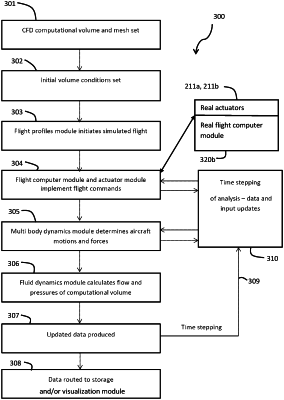| CPC G09B 9/24 (2013.01) [G06F 30/28 (2020.01)] | 7 Claims |

|
1. A computer-implemented method of generating a fluid flow simulation over a computational volume, said method comprising:
obtaining a fluid-flow mesh or grid in computer memory, the fluid flow mesh or grid encompassing a computational volume defined in a first coordinate frame, the fluid flow mesh or grid comprising a plurality of cells or grid points;
obtaining an aircraft representation based in a second coordinate frame in computer memory;
obtaining initial conditions for the fluid flow mesh or grid in computer memory;
obtaining lifting surface elements of said aircraft representation in computer memory, said lifting surface elements representing slices of the lifting surfaces;
obtaining lift information from aerodynamic tables in computer memory for each slice;
fixedly coupling said second coordinate frame with said aircraft representation in said first coordinate frame with said computational volume, using a computer processor, wherein said aircraft representation comprises a representation of force actuators onto the fluid;
determining, using the computer processor, an updated induced velocity of the fluid based upon force inputs from the force actuators representing the aircraft frame using a discretized fluid flow solver;
determining, using the computer processor, the forces upon said slices of the lifting surfaces;
using the determined forces upon said slices of the lifting surfaces in said determination of said induced velocity;
determining, using the computer processor, a local Courant number for each mesh cell within the computational volume;
determining, using the computer processor, an updated total advection within the computational volume based upon the induced velocity and the aircraft motion, wherein said advection determination method is based upon the local Courant number for each mesh cell or grid point; and
storing an updated total advection in computer memory.
|